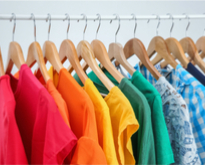The EU Member States exported clothes and footwear worth €141.8 billion in 2017, the majority of which went to other EU Member States (77%, or €109.6 billion). Compared to 2013, exports of clothing and footwear from the EU Member States increased in value by 29%.
€195.8 billion of clothes and footwear were imported by the EU Member States, of which almost half was imported from non-EU Member States (49%, or €95.4 billion). Compared to 2013, this represents an increase of 30% in the value of total imports of the EU Member States.
As data are not yet available for December 2017, for the purposes of this news article, annual data for 2013 and 2017 refer to January to November values only.
Italy and Germany, largest clothing and footwear exporters
Italy exported clothes and footwear worth €26.6 billion in 2017. This represented 19% of total EU exports of clothes and footwear. This makes Italy the largest EU exporter of clothes and footwear, followed by Germany (€22.8 billion, 16%) and Spain (€14.3 billion, 10%), ahead of Belgium (€12.5 billion, 9%) and France (€12.0 billion, 8%).
Germany, the largest importer of clothes and footwear
In 2017, €39.9 billion-worth of clothes and footwear were imported by Germany (over 20% of total imports of clothes and footwear in value). This makes Germany the largest EU importer of clothing and footwear, followed by France (€25.5 billion, 13%), the United Kingdom (€23.5 billion, 12%), Spain (€17.8 billion, 9%) and Italy (€17.5 billion, 9%).
Among non-EU countries, Switzerland was the main destination for EU exports of clothes and footwear. The EU Member States sent €6.4 billion of clothes and footwear to Switzerland in 2017 (representing 20% of the total value of extra-EU exports of clothes and footwear). The next largest market was the United States (€4.5 billion, 14%). Other major destinations were Russia (€2.9 billion, 9%), Hong Kong (€2.3 billion, 7%), Japan (€1.7 billion, 5%) and China (€1.6 billion, 5%).
Imports of clothes and footwear from non-EU countries came mainly from China (€33.4 billion, or 35% of total extra-EU clothes and footwear imports), Bangladesh (€14.6 billion, 15%) and Türkiye(€9.1 billion, 9%), followed by Vietnam (€6.7 billion, 7%), India (€6.0 billion, 6%) and Cambodia (€4.0 billion, 4%).
Female clothing top for EU exports and imports
The EU Member States exported almost €21 billion worth of female suits, jackets, blazers, dresses and skirts, accounting for one fifth of total EU clothes exports (21%). At the same time, €29.0 billion worth of the same group of products were imported into the EU, representing 20% of total clothes imports.
Male suits, jackets, blazers and trousers with a value of €12.8 billion were exported, or 13% of total clothes exports. At the same time, the EU imported €18.1 billion worth of the same items, 12% of all clothing imports.
The third largest category of clothing and footwear imports and exports was jerseys, pullovers, cardigans, waistcoats and similar articles for males and females. Exports of these items had a value of €11.2 billion, accounting for 11% of total clothing exports. The EU Member States imported €17.3 billion worth of the same items - 12% of total clothing imports.
Clothing and footwear: most expensive in Sweden, least expensive in Bulgaria
The price levels of clothing and footwear vary considerably across the EU Member States. In 2016, the highest prices for clothing and footwear were recorded in Sweden (36% higher than the EU average), followed by Denmark (33%) and Finland (24%).
Bulgaria was the least expensive country for clothing (21% lower than the EU average), followed by Hungary (15%) and Poland (12%).
In 2016, the highest share of household expenditure spent on clothing and footwear was recorded in Estonia (7% of total expenditure), followed by Italy and Portugal (both 6%), while these shares were lowest in Bulgaria (3%), Hungary and the Czech Republic (both 4%).
The source dataset for price level statistics can be accessed here, and for household consumption expenditure it can be accessed here.
For more information:
A data visualisation tool on consumer price levels in the EU
A data visualisation tool on household expenditure by purpose in the EU
Statistics Explained article on Comparative price levels of consumer goods and services
Statistics Explained article on Household consumption by purpose
For more information, please contact us: estat-user-support@ec.europa.eu .

